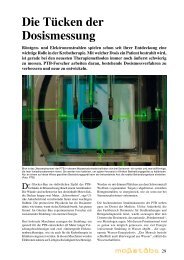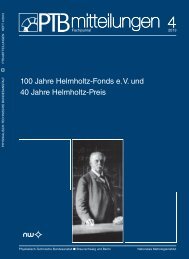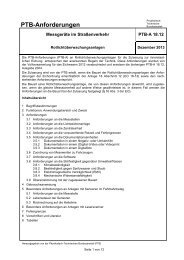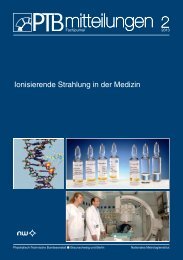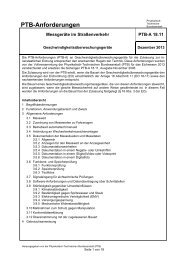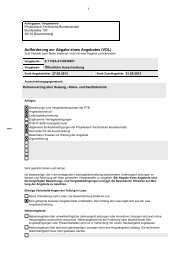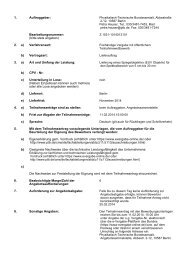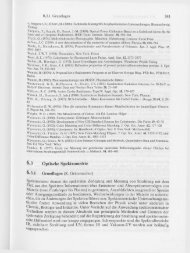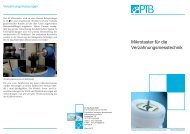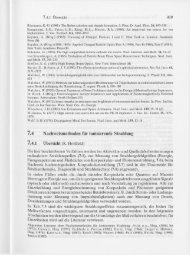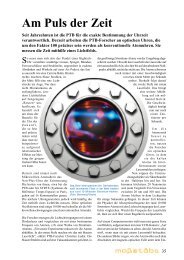PTB-Jahresbericht 2005
PTB-Jahresbericht 2005
PTB-Jahresbericht 2005
Sie wollen auch ein ePaper? Erhöhen Sie die Reichweite Ihrer Titel.
YUMPU macht aus Druck-PDFs automatisch weboptimierte ePaper, die Google liebt.
Nachrichten des Jahres • News of the year<br />
Technologietransferpreis für<br />
Zahnimplantatsystem<br />
Eine vollkommen neue Zahnimplantattechnik<br />
wurde von der Industrie- und Handelskammer<br />
Braunschweig mit dem Technologietransferpreis<br />
ausgezeichnet. Professor Manfred<br />
Peters von der Physikalisch-Technischen<br />
Bundesanstalt hat das System gemeinsam mit<br />
Mitarbeitern des Universitätsklinikums<br />
Aachen und der Firma Heraeus bereits bis zur<br />
Marktreife entwickelt. Der Clou der neuen<br />
Technik: Sie kommt, im Gegensatz zu allen<br />
anderen Produkten, ohne jede Verschraubung<br />
aus.<br />
Unter dem Produktnamen „IQ:Nect“ wird<br />
Heraeus das Implantatsystem im Jahr 2006 in<br />
Deutschland einführen, nachdem mehrere<br />
Millionen Euro in die Entwicklungs- und<br />
Testphase investiert worden sind. In einer<br />
Langzeitstudie wurden bis jetzt insgesamt 150<br />
Patienten mit knapp 500 Implantaten versorgt<br />
– mit überzeugenden Ergebnissen. „Das<br />
Implantatsystem“, so Heraeus in einem<br />
Schreiben an die IHK, „ist ein hervorragendes<br />
Beispiel für Technologietransfer und eng<br />
verzahnte Projektarbeit, in der Expertenwissen<br />
aus Wissenschaft, Klinik und der Praxis<br />
optimal kombiniert wurden.“<br />
Das jetzt prämierte Zahnimplantatsystem<br />
benötigt – im Gegensatz zu fast allen anderen<br />
Implantatsystemen – keine inneren Verschraubungen,<br />
sondern setzt auf einen Clipmechanismus<br />
und eine neuartige Verbindungstechnologie<br />
über chemisch ausgehärtete<br />
Sprengringe. Innere Spannungen treten bei<br />
diesem Zahnersatz nicht mehr auf. Und: Die<br />
Handhabung des Systems ist – präzise gefertigte<br />
Systemteile vorausgesetzt – deutlich<br />
einfacher, so dass Fehlermöglichkeiten für<br />
Zahnarzt und Zahntechniker auf ein Minimum<br />
reduziert werden.<br />
IHK-Präsident Dr. Klaus Schuberth überreicht<br />
Prof. Manfred Peters den<br />
Technologietransferpreis.<br />
The president of the IHK, Dr. Klaus<br />
Schuberth, presents the technology transfer<br />
prize to Prof. Manfred Peters.<br />
30<br />
Technology Transfer Prize for dental<br />
implant system<br />
For the development of a novel dental implant<br />
technology, Professor Manfred Peters<br />
from the Physikalisch-Technische Bundesanstalt<br />
has been awarded the Technology<br />
Transfer Prize by the Chamber of Industry<br />
and Commerce (IHK) of Braunschweig.<br />
Together with colleagues from the Aachen<br />
University Clinic and the company of<br />
Heraeus, he has already developed the system<br />
for market readiness. The revolutionary idea<br />
behind this new technique: in contrast to all<br />
other products, no screws are required.<br />
In 2006, Heraeus will launch the implant<br />
system onto the German market under the<br />
brand name “IQ:Nect“ after several millions<br />
of Euro have been invested into the development<br />
and test phase. Within the scope of a<br />
long-term study, so far 150 patients have been<br />
provided with approx. 500 implants – which<br />
has led to convincing results. “The implant<br />
system“, says Heraeus in a letter addressed to<br />
the IHK, “is an outstanding example of technology<br />
transfer and closely intertwined<br />
project work which has optimally combined<br />
expert knowledge from science, medical<br />
theory and practice.“<br />
Contrary to nearly all other implant systems,<br />
this new dental implant system requires no<br />
interior screws. Instead, it is based on a clipping<br />
mechanism and a novel connecting<br />
technology using chemically hardened snap<br />
rings. Internal strains no longer occur with<br />
this kind of dental implant. Furthermore, the<br />
system is much easier to handle – provided<br />
the system parts were designed precisely – so<br />
that the risk of making an error is reduced to<br />
a minimum for the dentist and the dental<br />
technician.



